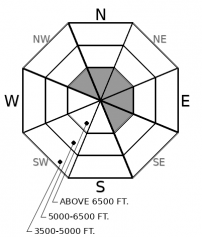| Wednesday | Wednesday Night | Thursday | |
|---|---|---|---|
| Cloud Cover: | Partly Cloudy | Mostly Cloudy | Mostly Cloudy |
| Temperatures: | 20 to 26 deg. F. | 12 to 16 deg. F. | 24 to 31 deg. F. |
| Wind Direction: | Northeast | Southwest | Southwest |
| Wind Speed: | 9G21 | 14G24 | 20G39 |
| Snowfall: | 0" in. | 0" in. | 0" in. |
| Snow Line: | 0' | 500' | 1000' |
Whitefish Range
How to read the forecast
Enjoy generally stable avalanche conditions with isolated areas of wind drifted snow. This wind drifted snow should be easy to identify below recent cornice formation or pillow looking surfaces. If you see fresh drifts, steer around them. Small slides can be consequential if they push you into a stand of trees or over a cliff band.

1. Low
?
Above 6500 ft.
1. Low
?
5000-6500 ft.
1. Low
?
3500-5000 ft.
- 1. Low
- 2. Moderate
- 3. Considerable
- 4. High
- 5. Extreme
-
Type ?
-
Aspect/Elevation ?

-
Likelihood ?CertainVery LikelyLikelyPossible
 Unlikely
Unlikely -
Size ?HistoricVery LargeLargeSmall

In the Whitefish Range, expect shallow, isolated wind slabs that will be consequential if they push you into a terrain trap. Steer around dense, pillowy slabs of drifted snow by sticking to terrain that was sheltered by the wind. Yesterday's strong winds were out of the southwest, but be aware that winds have shifted to the north overnight. Don't get caught off guard by small pockets of drifted snow, some of which may be found in unusual locations today.
Yesterday the Swan Range, Flathead Range, and Glacier National Park picked up 4 to 10 inches of new snow on top of 2 to 5 inches of snow on Sunday night. Sustained moderate southwest winds, with stronger gusts, built sensitive wind slabs 8 to 12+ inches thick. The Whitefish Range picked up 2 to 3 inches of new snow, leading to a much calmer day there, as described here. Observers around the forecast area found increasing avalanche danger, most notably in the Flathead Range and Glacier National Park Region (example 1, example 2). Forecaster, Blase Reardon said it well yesterday, it was "the kind of hazard you might manage. Or that might manage you."
Expect wind slabs formed yesterday to be the primary problem to manage today. A benign weather pattern today will make identifying wind slabs less obvious since we won't be watching active wind loading like we were yesterday. Instead, look for surface clues. Shooting cracks, pillowy surfaces, and recent cornice formations are all signs to seek out terrain that was sheltered by the wind. Be on the look out since winds shifted to the north overnight, creating a possibility of isolated pockets of wind slabs on atypical south and southwest aspects. These should be relatively small, but ones to look for since they will be in unusual locations. One uncertainty we have moving forward is if the additional wind loading has re-activated buried faceted crusts that were touchy this past weekend. If triggered, slides could step down 1 to 3 feet deep and have a more consequential outcome.
A weak weather system will move into the area today. Expect scattered snow showers with a possible trace of snow accumulation. Winds will be light gusting to moderate out of the northeast. We can expect mostly cloudy skies and temperatures in the upper twenties.
This forecast applies only to backcountry areas outside established ski area boundaries. The forecast describes general avalanche conditions and local variations always occur. This forecast expires at midnight on the posted day unless otherwise noted. The information in this forecast is provided by the USDA Forest Service who is solely responsible for its content.




















